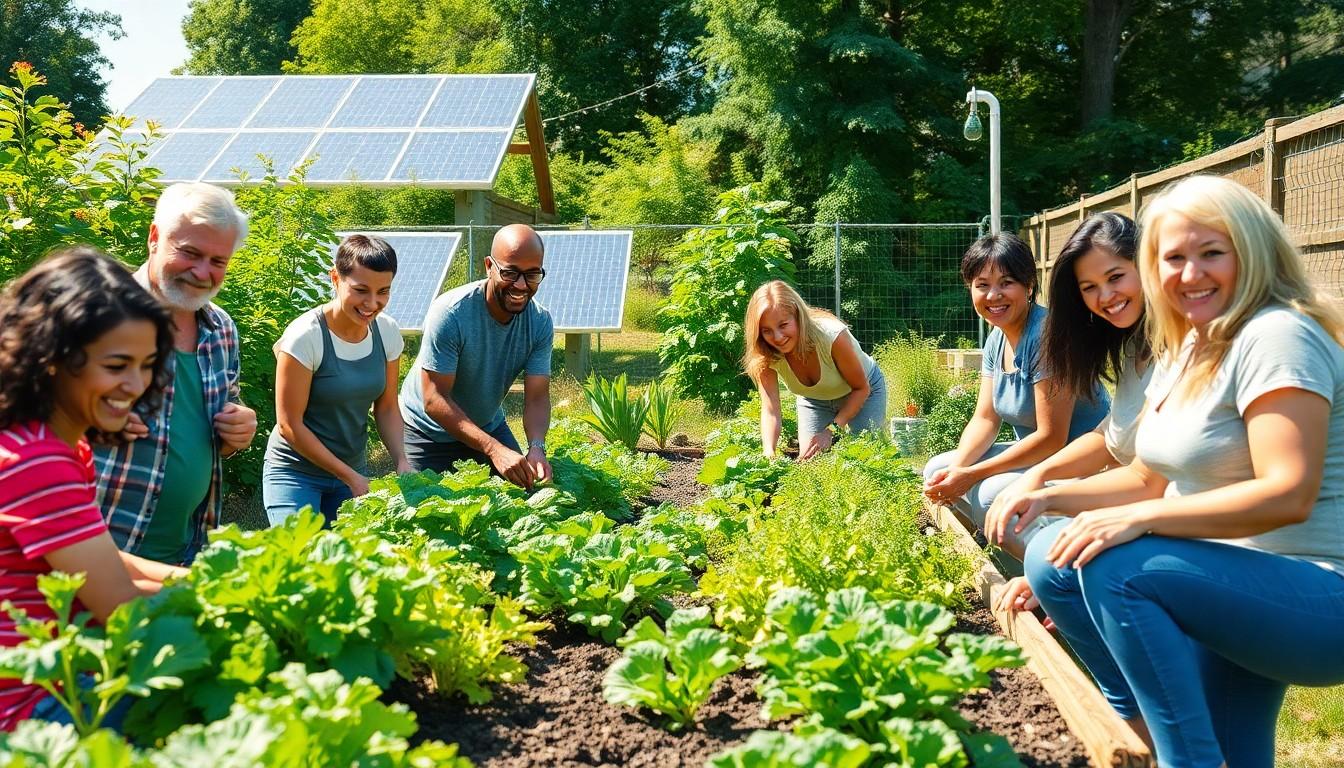In a world where plastic seems to multiply faster than rabbits and climate change feels like that uninvited guest who just won’t leave, sustainable living solutions have become more essential than ever. Imagine a life where your choices not only save the planet but also make you feel like a superhero in your own right. Sounds appealing, right?
Sustainable living isn’t just a trend; it’s a lifestyle that’s gaining momentum faster than a toddler on a sugar rush. From eco-friendly products to energy-efficient homes, there are countless ways to reduce one’s carbon footprint without sacrificing comfort or style. Dive into the world of sustainable solutions and discover how small changes can lead to a greener, happier planet. Who knew saving the Earth could be this much fun?
Sustainable Living Solutions
Sustainable living solutions encompass various strategies aimed at reducing environmental impact. These solutions often include practices that conserve resources, reduce waste, and promote ecological balance. Key areas of focus include energy efficiency, waste reduction, and the use of renewable resources.
Energy-efficient homes feature insulation, energy-saving appliances, and smart technology. These innovations help households lower energy consumption while maintaining comfort. As a result, homeowners enjoy lower utility bills and a smaller carbon footprint.
Waste reduction emphasizes minimizing plastic usage, composting, and recycling. Many individuals adopt reusable items, such as water bottles and shopping bags, to lessen their reliance on single-use materials. Such practices not only help reduce landfill waste but also promote a culture of sustainability.
Using renewable resources represents another critical aspect of sustainable living. Solar panels, wind turbines, and geothermal systems provide clean energy alternatives. These options significantly decrease reliance on fossil fuels, contributing to a healthier environment.
Sustainable food choices contribute to this lifestyle as well. Organic farming and local sourcing reduce chemical use and transportation emissions. Eating a plant-based diet also aligns with sustainable principles, as it typically involves lower resource consumption compared to meat production.
Transportation solutions have also evolved, reflecting the shift towards sustainability. Electric vehicles and public transit options help reduce greenhouse gas emissions, positioning individuals and communities as part of the solution. Embracing biking and walking further promotes sustainable transport.
Ultimately, sustainable living solutions present actionable methods for individuals to make meaningful changes. Small, consistent efforts yield significant benefits for the planet, emphasizing that everyone can contribute to a more sustainable future.
Benefits of Sustainable Living
Sustainable living offers multiple advantages, contributing to both environmental health and economic stability. These benefits demonstrate the importance of adopting eco-friendly practices.
Environmental Advantages
Natural ecosystems thrive under sustainable practices, leading to reduced pollution and improved air quality. Cleaner air results from decreased reliance on fossil fuels and minimized waste. Biodiversity maintains balance as organic farming and responsible land use preserve habitats. Renewable resources, such as solar and wind energy, lessen dependence on non-renewable sources. Water conservation efforts, including rainwater harvesting, safeguard freshwater supplies. These collective efforts significantly lower carbon footprints, empowering individuals to combat climate change.
Economic Benefits
Investing in sustainable living often leads to long-term financial savings. Energy-efficient homes lower utility bills through reduced energy consumption. Individuals who adopt sustainable transportation options save on fuel costs while enjoying tax incentives. Local economies thrive as consumers buy from eco-friendly businesses and support sustainable agriculture. Job creation finds a boost in renewable energy sectors like solar and wind. Implementing waste reduction strategies streamlines costs associated with waste management. These economic advantages encourage individuals to embrace sustainable solutions for greater financial resilience.
Key Sustainable Living Solutions
Sustainable living offers tangible solutions to combat environmental issues. Each solution contributes to healthier living and a reduced ecological footprint.
Energy Efficiency

Implementing energy-efficient practices significantly lowers energy consumption. Homes can incorporate insulation, which minimizes heat loss and reduces heating costs. Energy-saving appliances like LED light bulbs and smart thermostats enhance savings on electricity bills. Utilizing smart technology allows for greater control over energy use, achieving optimal efficiency. According to the U.S. Department of Energy, these strategies can cut energy bills by 10 to 50 percent. Adopting such measures benefits both the environment and personal finances.
Waste Reduction Strategies
Minimizing waste involves adopting various strategies to lessen reliance on single-use items. Choosing reusable products instead of disposable ones dramatically reduces plastic consumption. Composting food scraps and yard waste enriches soil while diverting waste from landfills. Recycling materials such as glass, paper, and metals transforms waste into new products. Experts note that recycling can save significant energy compared to producing items from raw materials. Simple changes, like bringing reusable bags to the store, contribute to an overarching waste reduction effort.
Sustainable Transportation
Sustainable transportation options minimize greenhouse gas emissions and promote healthier communities. Electric vehicles (EVs) provide a cleaner alternative to traditional gas-powered cars, helping reduce air pollution. Many cities invest in public transit systems, making it easier for individuals to choose alternatives to personal vehicles. Biking and walking serve as effective methods for short distances, increasing physical health while decreasing carbon footprints. A report by the Environmental Protection Agency underscores the benefits of EV adoption in reducing overall emissions. Embracing these transportation solutions plays a crucial role in achieving a sustainable future.
Implementing Sustainable Practices at Home
Adopting sustainable practices at home fosters a healthier environment. Several strategies enhance eco-friendliness and energy efficiency.
Eco-Friendly Home Improvements
Installing energy-efficient appliances represents a key improvement. These appliances cut energy usage by 10 to 50 percent, according to the U.S. Department of Energy. Adding insulation reduces heating and cooling needs, further lowering utility bills. Utilizing smart home technology optimizes energy consumption by automatically adjusting settings. Choosing natural materials for construction and decor supports a sustainable lifestyle while promoting indoor air quality.
Sustainable Gardening Tips
Starting a garden provides a hands-on approach to sustainability. Planting native species attracts local wildlife and supports biodiversity. Composting kitchen scraps returns nutrients to the soil and minimizes waste sent to landfills. Implementing rainwater collection systems conserves water for gardening needs. Using organic fertilizers and pesticides limits chemical runoff into local waterways. Exploring companion planting encourages healthy plant growth while reducing pests naturally. By engaging in sustainable gardening, individuals contribute to a greener planet.
Healthier Planet
Embracing sustainable living solutions is essential for a healthier planet and a brighter future. By making conscious choices and adopting eco-friendly practices, individuals can significantly reduce their environmental impact. Every small change counts, whether it’s optimizing energy use at home or choosing sustainable transportation options.
These efforts not only foster a more sustainable lifestyle but also lead to economic benefits. Investing in renewable resources and waste reduction strategies can lower utility bills and support local economies. As more people commit to sustainable practices, the collective impact can drive meaningful change. The journey toward sustainability starts with individual actions that ripple out to create a larger effect.







